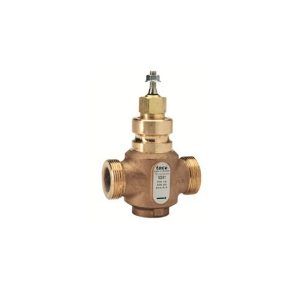TAC – Schneider Electric dvieigiai vožtuvai V241 gali būti naudojami daugelyje ŠVOK sričių, tokių kaip šildymas, aušinimas, vėdinimas ir karšto vandens ruošimas namuose.
 Pagrindiniai V241 techniniai parametrai
Pagrindiniai V241 techniniai parametrai
- Slėgio klasė: PN 16
- Charakteristika: EQM
- Eiga: 20 мм
- ∆Pm: max 600 kPa
- Pratekėjimas: max 0.02% от Kv
- Šilumnešio temperatūra: min -20 °C, max +150 °C
Vožtuvų TAC išskirtinė savybė – aukštas darbinis tikslumas, kai šilumos perdavimas visada proporcingas valdymo signalui. Aukšto vožtuvo valdymo charakteristikų tikslumo dėka ženkliai sumažėja elektros energijos sąnaudos. Kaip žinia, patalpų mikroklimato sistemų valdymo optimizacija didžiąja dalimi priklauso nuo vožtuvų kokybės. Senus sistemoje turimus vožtuvus pakeitus naujaisiais TAC vožtuvais, investicijų atsipirkimas bus gana greitas.
TAC dvieigiai vožtuvai patogūs eksploatacijoje – jiems praktiškai nereikalingas aptarnavimo servisas, o tai akivaizdus privalumas. Šio tipo vožtuvai yra savaime apsivalantys, atsparūs poveikiui kietųjų dalelių, esančių vandenyje, bei atsparūs korozijai.
V241 charakteristikos
V241 konstrukcija suteikia gerą atsparumą kietosioms skysčio dalelėms.
Kaištis nukreipiamas per visą keltuvą, todėl sumažėja vibracijos rizika. Vožtuvas užsidaro stiebu aukštyn.
V241 srauto charakteristikos yra modifikuotos vienodu santykiu. Ši savybė leidžia valdyti mažus debitus iki beveik uždarytos padėties. Tai ypač svarbu norint pasiekti gerą valdymo našumą sistemose, kuriose labai skiriasi apkrova.
Montavimas
Vožtuvas V241 turi būti sumontuotas srauto kryptimi pagal vožtuvo ženklinimą. Rekomenduojama vožtuvą įmontuoti į grįžtamąjį vamzdį, kad pavara nepatektų į aukštą temperatūrą. Vožtuvo negalima montuoti su pavara, pritvirtinta žemiau vožtuvo. Norint užtikrinti, kad kietosios dalelės neužstrigtų tarp vožtuvo kaiščio ir lizdo, prieš vožtuvą reikia įrengti filtrą, o prieš įrengiant vožtuvą – praplauti vamzdžių sistemą.
Dvieigiai reguliavimo vožtuvai – „Absoliuta” sandėlyje: plačiau.
The V241 is a high quality general purpose valve
Polished stainless seats provide high differential pressure capability and low leakage.
Suitable for a wide range of applications such as heating, cooling, air handling and domestic hot water systems. The valve can handle hot and cold water with phosphate, hydrazine and antifreeze additives.
The valve can handle the following types of media:
- Hot and chilled water.
- Water containing phosphate or hydrazine additives.
- Water with antifreeze additives such as glycol.
If the valve is used for media at temperatures below 0 °C (32 °F), it should be equipped with a heater in order to prevent ice formation on the valve stem.
TAC Venta globe valves offer high rangeability, are self cleaning, offer low leakage and have a robust packing box.
Two-way Plug Valve, Bronze PN 16 (232 psi)
V241 can be used in a wide range of applications, such as heating, cooling, air handling and domestic hot water systems.
- Design: 2-way plug valve, stem up closed
- Pressure class: PN 16
- Flow characteristic: Equal percentage modified
- Stroke: 20 mm
- Rangeability Kvs/Kv min: 0,25 – 38
- Leakage: up to 0.02% of Kv
- ∆Pm: 600 kPa, water
- Max. temperature of medium: 150°C
- Min. temperature of medium: -20°C
- Max. glycol/concentration: 50%
- Connection: External pipe thread according to ISO 228/1
- Materials:
- Body: Bronze Rg5
- Plug and seat: Stainless steel SS 2346
- Stem: Stainless steel SS 2346
Design and characteristics
The design of the V241 gives good resistance against solid particles in the fluid. The plug is guided throughout the lift, which reduces the risk for vibrations. The valve closes with the stem up. The flow characteristics of the V241 is equal percentage modified. This characteristic makes it possible to control low flow rates down to almost closed position. This is particularly important for achieving good control performance in systems with wide load variations.
Instaliation
The valve should be mounted with flow direction in accordance with the valve marking. It is recommended to install the valve in the return pipe, in order to avoid exposing the actuator to high temperatures. The valve must not be installed with the actuator mounted below the valve.
To ensure that suspended solids will not become jammed between the valve plug and seat, a filter should be installed upstream of the valve, and the pipe system should be flushed before the valve is installed.
…
